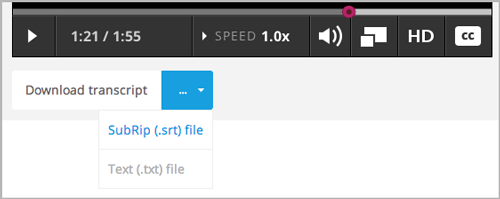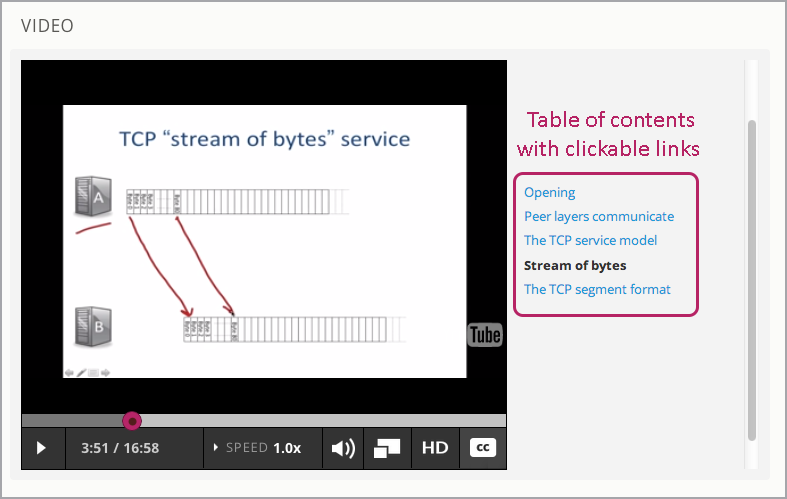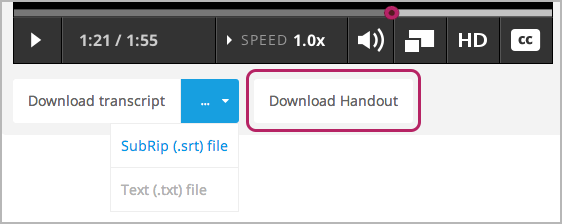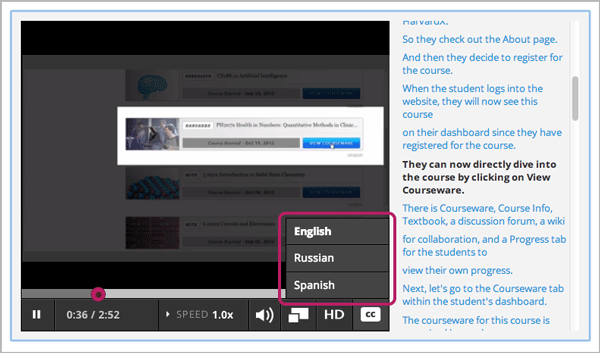7.2. Working with Video Components¶
7.2.1. Introduction to Videos¶
You can create a video of your lecture and add it to your course with other components—such as discussions and problems—to promote active learning. Adding a video to your course has several steps.
- Step 1. Create the Video.
- Step 2. Create or Obtain a Video Transcript.
- Step 3. Post the Video Online.
- Step 4. Create a Video Component.
Also see:
Note
Review Best Practices for Accessible Media before adding videos to your course.
To help course teams protect video assets, the edX video player hides video URLs from students by default. This functionality is in effect for all video files, including YouTube videos and videos that you have posted in other locations. Students can still download videos if you select the Video Download Allowed option for your video components. For more information about posting non-YouTube videos online, see Step 3. Post the Video Online. For more information about options that you can set when you create a video component, see Advanced Options under Step 4. Create a Video Component.
7.2.2. Step 1. Create the Video¶
Your videos can contain whatever content you want to include in the course. The Creating Videos section of edX101 Overview of Creating an edX Course has some helpful pointers for creating good video content.
7.2.2.1. Compression Specifications¶
When you create your video, edX recommends the following compression specs. (Note that these are recommended but not required.)
| Output | Publish to YouTube | Publish downloadable file to AWS S3 |
|---|---|---|
| Codec | H.264 .mp4 | H.264 .mp4 |
| Resolution & Frame Rate (see note) | 1920x1080, progressive, 29.97 fps | 1280x720, progressive, 29.97 fps |
| Aspect | 1.0 | 1.0 |
| Bit Rate | VBR, 2 pass | VBR, 2 pass |
| Target VBR | 5 mbps | 1 mbps |
| Max VBR | 7.5 mbps | 1.5 mbps |
| Audio | AAC 44.1 / 192 kbps | AAC 44.1 / 192 kbps |
Note
Typically you export at the same frame rate that was used when you created the media file. For example, if you create the file in a country that uses the PAL system, you export at 25 fps instead of the NTSC standard of 29.97 fps.
7.2.2.2. Video Formats¶
The edX video player supports videos in .mp4, .webm, .mpeg, and .ogg format. However, to help make sure all standard browsers can play your video, we strongly recommend that you use the .mp4 or .webm format.
7.2.3. Step 2. Create or Obtain a Video Transcript¶
Transcripts are required for your videos. Transcripts are helpful for students who are viewing a video in a language other than their native language, who are unable to watch the video, or who want to review the content of the video. You can allow students to download transcripts so that they can read them offline. You associate a transcript with a video when you create the video component.
Timed transcripts in the SubRip Text (.srt) format are strongly recommended. A transcript in the .srt format appears next to its associated video and automatically scrolls as the video plays. A student can click a word in the transcript to jump to the point in the video where that word is spoken.
To create or obtain a transcript in .srt format, you can work with a company that provides captioning services. EdX works with 3Play Media. YouTube also provides captioning services.
When you upload an .srt file, a .txt file is created automatically. You can allow students to download these transcript files. If you allow your students to download transcripts, a Download transcript button appears under the video. Students can then select either SubRip (.srt) file or Text (.txt) file to download the .srt or .txt transcript.

You can also provide transcripts in different formats, such as .pdf, and you can provide transcripts in different languages. For more information about these options, see Additional Transcripts.
Note
Historically, some courses used .sjson files for video transcripts. Use of .sjson files is no longer recommended; however, if transcripts in your course use this format, see Steps for .sjson Files.
7.2.4. Step 3. Post the Video Online¶
All course videos should be posted to YouTube. By default, the edX video player accesses your YouTube videos.
Because YouTube is not available in all locations, however, we recommend that you also post copies of your videos on a third-party site such as Amazon S3. When a student views a video in your course, if YouTube is not available in that student’s location or if the YouTube video doesn’t play, the video on the backup site starts playing automatically. You can also allow the student to download the video from the backup site.
After you post your video online, make sure you have the URL for the video. If you host copies of your video in more than one place, make sure you have the URL for each video location.
7.2.4.1. YouTube¶
After you create your video, upload the video to YouTube.
Note
YouTube only hosts videos of up to 15 minutes. If you create a 0.75-speed option, you must make sure that your 1.0-speed video segments are only 11.25 minutes long so that YouTube can host all speeds. YouTube offers paid accounts that relax this restriction.
7.2.4.2. Other Sites¶
You can use any video backup site that you want. However, keep in mind that the site where you post the videos may have to handle a lot of traffic.
Note
The URL for the video that you post on a third-party site must end in .mp4, .webm, .mpeg, or .ogg. (To help make sure all standard browsers can play your video, we strongly recommend that you use .mp4 or .webm format.) EdX cannot support videos that you post on sites such as Vimeo.
7.2.5. Step 4. Create a Video Component¶
Under Add New Component, click Video.
When the new video component appears, click Edit. The video editor opens to the Basic tab.

You replace the default values with your own.
In the Component Display Name field, enter the name you want students to see when they hover the mouse over the unit in the course ribbon. This text also appears as a header for the video.
In the Default Video URL field, enter the URL of the video. For example, the URL may resemble one of the following.
http://youtu.be/OEoXaMPEzfM http://www.youtube.com/watch?v=OEoXaMPEzfM https://s3.amazonaws.com/edx-course-videos/edx-edx101/EDXSPCPJSP13-G030300.mp4 https://s3.amazonaws.com/edx-videos/edx101/video4.webm
Note
To be sure all students can access the video, we recommend providing both an .mp4 and a .webm version of your video. To do this, you can post additional versions of your videos on the Internet, then add the URLs for these versions below the default video URL. These URLs cannot be YouTube URLs. To add a URL for another version, click Add URLs for additional versions. The first listed video that is compatible with the student’s computer will play.
Next to Default Timed Transcript, select an option.
If edX already has a transcript for your video–for example, if you are using a video from an existing course–Studio automatically finds the transcript and associates the transcript with the video.
If you want to modify the transcript, click Download Transcript for Editing. You can then make your changes and upload the new file by clicking Upload New Transcript.
If edX does not have a transcript for the video, but YouTube has a transcript, Studio automatically finds the YouTube transcript and asks if you want to import it. To use this YouTube transcript, click Import YouTube Transcript. (If you want to modify the YouTube transcript, import the YouTube transcript into Studio, and then click Download Transcript for Editing. You can then make your changes and upload the new file by clicking Upload New Transcript.)
If both edX and YouTube have a transcript for your video, but the edX transcript is out of date, you receive a message asking if you want to replace the edX transcript with the YouTube transcript. To use the YouTube transcript, click Yes, replace the edX transcript with the YouTube transcript.
If neither edX nor YouTube has a transcript for your video, and your transcript uses the .srt format, click Upload New Transcript to upload the transcript file from your computer.
Note
- If your transcript uses the .sjson format, do not use this setting. For more information, see Steps for .sjson Files.
- If you want to provide a transcript in a format such as .pdf, do not use this setting to upload the transcript. For more information, see Additional Transcripts.
Optionally, click Advanced to set more options for the video. For a description of each option, see Advanced Options.
Click Save.
7.2.5.1. Advanced Options¶
The following options appear on the Advanced tab in the video component.
| Component Display Name | The name that you want your students to see. This is the same as the Display Name field on the Basic tab. |
| Default Timed Transcript | The name of the transcript file that is used in the Default Timed Transcript field on the Basic tab. This field is auto-populated. You do not have to change this setting. |
| Download Transcript Allowed | Specifies whether you want to allow students to download the timed transcript. If you set this value to True, a link to download the file appears below the video. By default, Studio creates a .txt transcript when you upload an .srt transcript. Students can download the .srt or .txt versions of the transcript when you set Download Transcript Allowed to True. If you want to provide the transcript for download in a different format as well, such as .pdf, upload a file to Studio by using the Upload Handout field. |
| Downloadable Transcript URL | The URL for a non-.srt version of the transcript file posted on the Files & Uploads page or on the Internet. Students see a link to download the non-.srt transcript below the video. When you add a transcript to this field, only the transcript that you add is available for download. The .srt and .txt transcripts become unavailable. If you want to provide a downloadable transcript in a format other than .srt, we recommend that you upload a handout for students by using the Upload Handout field. For more information, see Additional Transcripts. |
| EdX Video ID | An optional field used only by course teams that are working with edX to process and host video files. |
| Show Transcript | Specifies whether the transcript plays along with the video by default. |
| Transcript Languages | The transcript files for any additional languages. For more information, see Transcripts in Additional Languages. |
| Upload Handout | Allows you to upload a handout to accompany this video. Your handout can be in any format. Students can download the handout by clicking Download Handout under the video. |
| Video Download Allowed | Specifies whether students can download versions of this video in different formats if they cannot use the edX video player or do not have access to YouTube. If you set this value to True, you must add at least one non-YouTube URL in the Video File URLs field. |
| Video File URLs | The URL or URLs where you posted non-YouTube versions of the video. Every URL should end in .mpeg, .webm, .mp4, or .ogg and cannot be a YouTube URL. Each student will be able to view the first listed video that is compatible with the student’s computer. To allow students to download these videos, you must set Video Download Allowed to True. To help make sure all standard browsers can play your video, we strongly recommend that you use the .mp4 or .webm format. |
| Video Start Time | The time you want the video to start if you do not want the entire video to play. Formatted as HH:MM:SS. The maximum value is 23:59:59. |
| Video Stop Time | The time you want the video to stop if you do not want the entire video to play. Formatted as HH:MM:SS. The maximum value is 23:59:59. |
| YouTube IDs | If you have uploaded separate video files to YouTube for different speeds of your video (YouTube ID for .75x speed, YouTube ID for 1.25x speed, YouTube ID for 1.5x speed), enter the YouTube IDs for these videos in these fields. These settings are optional, to support video play on older browsers. |
7.2.6. Video Table of Contents¶
You can add a table of contents for your video by adding an .srt transcript file that contains clickable links to different parts of the video. When your students view the video, they can click the CC button at the bottom of the video player to switch between the main transcript for the video and the table of contents.
To add a table of contents, you work with a third-party service to create the .srt transcript file. Then, you use the Transcript Languages setting in the video component to associate the .srt file with the video.

After you obtain the .srt transcript file that will function as the table of contents, open the video component for the video.
On the Advanced tab, scroll down to Transcript Languages, and then click Add.
In the drop-down list that appears, select Table of Contents.
An Upload button appears.
Click Upload, browse to the .srt file for the transcript, and then click Open.
In the Upload translation dialog box, click Upload.
7.2.7. Additional Transcripts¶
By default, a .txt file is created when you upload an .srt file, and students can download an .srt or .txt transcript when you set Download Transcript Allowed to True. The Download Transcript button appears below the video, and students see the .srt and .txt options when they hover over the button.

If you want to provide a downloadable transcript in a format such as .pdf along with the .srt and .txt transcripts, we recommend that you use the Upload Handout field. When you do this, a Download Handout button appears to the right of the Download Transcript button, and students can download the .srt, .txt, or handout version of the transcript.

To add a downloadable transcript by using the Upload Handout field:
- Create or obtain your transcript as a .pdf or in another format.
- In the video component, click the Advanced tab.
- Locate Upload Handout, and then click Upload.
- In the Upload File dialog box, click Choose File.
- In the dialog box, select the file on your computer, and then click Open.
- In the Upload File dialog box, click Upload.
Before Studio added the Upload Handout feature, some courses posted transcript files on the Files & Uploads page or on the Internet, and then added a link to those files in the video component. We no longer recommend this method. When you use this method, the Download Transcript button appears, but only the transcript that you add is available for download. The .srt and .txt transcripts become unavailable.

If you want to use this method, you can post your transcript online, and then add the URL to the transcript in the Downloadable Transcript URL field. However, bear in mind that students will not be able to download .srt or .txt transcripts.
7.2.7.1. Transcripts in Additional Languages¶
You can provide transcripts for your video in other languages. To do this, you work with a third-party service to obtain an .srt transcript file for each language, and then associate the .srt file with the video in Studio.
After you obtain the .srt files for additional languages, open the video component for the video.
On the Advanced tab, scroll down to Transcript Languages, and then click Add.
In the drop-down list that appears, select the language for the transcript that you want to add.
An Upload button appears below the language.
Click Upload, browse to the .srt file for the language that you want, and then click Open.
In the Upload translation dialog box, click Upload.
Repeat steps 2 - 5 for any additional languages.
Note
Make sure that all your transcript file names are unique to each video and language. If you use the same transcript name in more than one video component, the same transcript will play for each video. To avoid this problem, you could name your foreign language transcript files according to the video’s file name and the transcript language.
For example, you have two videos, named video1.mp4 and video2.mp4. Each video has a Russian transcript and a Spanish transcript. You can name the transcripts for the first video video1_RU.srt and video1_ES.srt, and name the transcripts for the second video video2_RU.srt and video2_ES.srt.
When your students view the video, they can click the CC button at the bottom of the video player to select a language.

7.2.8. Steps for .sjson Files¶
If your course uses .sjson files, you upload the .sjson file for the video to the Files & Uploads page, and then specify the name of the .sjson file in the video component.
Note
Only older courses that have used .sjson files in the past should use .sjson files. All new courses should use .srt files.
Obtain the .sjson file from a media company such as 3Play.
Change the name of the .sjson file to use the following format:
subs_{video filename}.srt.sjsonFor example, if the name of your video is Lecture1a, the name of your .sjson file must be subs_Lecture1a.srt.sjson.
Upload the .sjson file for your video to the Files & Uploads page.
Create a new video component.
On the Basic tab, enter the name that you want students to see in the Component Display Name field.
In the Video URL field, enter the URL of the video. For example, the URL may resemble one of the following.
http://youtu.be/OEoXaMPEzfM http://www.youtube.com/watch?v=OEoXaMPEzfM https://s3.amazonaws.com/edx-course-videos/edx-edx101/EDXSPCPJSP13-G030300.mp4
Click the Advanced tab.
In the Default Timed Transcript field, enter the file name of your video. Do not include subs_ or .sjson. For the example in step 2, you would only enter Lecture1a.
Set the other options that you want.
Click Save.